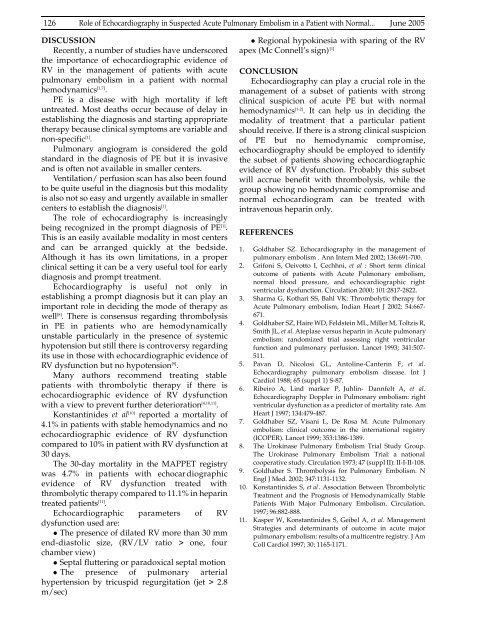42-03 Role of Echocardiogra.pdf
42-03 Role of Echocardiogra.pdf
42-03 Role of Echocardiogra.pdf
You also want an ePaper? Increase the reach of your titles
YUMPU automatically turns print PDFs into web optimized ePapers that Google loves.
126<br />
<strong>Role</strong> <strong>of</strong> <strong>Echocardiogra</strong>phy in Suspected Acute Pulmonary Embolism in a Patient with Normal... June 2005<br />
DISCUSSION<br />
Recently, a number <strong>of</strong> studies have underscored<br />
the importance <strong>of</strong> echocardiographic evidence <strong>of</strong><br />
RV in the management <strong>of</strong> patients with acute<br />
pulmonary embolism in a patient with normal<br />
hemodynamics [1,7] .<br />
PE is a disease with high mortality if left<br />
untreated. Most deaths occur because <strong>of</strong> delay in<br />
establishing the diagnosis and starting appropriate<br />
therapy because clinical symptoms are variable and<br />
non-specific [1] .<br />
Pulmonary angiogram is considered the gold<br />
standard in the diagnosis <strong>of</strong> PE but it is invasive<br />
and is <strong>of</strong>ten not available in smaller centers.<br />
Ventilation/ perfusion scan has also been found<br />
to be quite useful in the diagnosis but this modality<br />
is also not so easy and urgently available in smaller<br />
centers to establish the diagnosis [1] .<br />
The role <strong>of</strong> echocardiography is increasingly<br />
being recognized in the prompt diagnosis <strong>of</strong> PE [1] .<br />
This is an easily available modality in most centers<br />
and can be arranged quickly at the bedside.<br />
Although it has its own limitations, in a proper<br />
clinical setting it can be a very useful tool for early<br />
diagnosis and prompt treatment.<br />
E c h o c a rdiography is useful not only in<br />
establishing a prompt diagnosis but it can play an<br />
important role in deciding the mode <strong>of</strong> therapy as<br />
well [8] . There is consensus regarding thrombolysis<br />
in PE in patients who are hemodynamically<br />
unstable particularly in the presence <strong>of</strong> systemic<br />
hypotension but still there is controversy regarding<br />
its use in those with echocardiographic evidence <strong>of</strong><br />
RV dysfunction but no hypotension [9] .<br />
Many authors recommend treating stable<br />
patients with thrombolytic therapy if there is<br />
e c h o c a rdiographic evidence <strong>of</strong> RV dysfunction<br />
with a view to prevent further deterioration [4,10,11] .<br />
Konstantinides et al [10] reported a mortality <strong>of</strong><br />
4.1% in patients with stable hemodynamics and no<br />
e c h o c a rdiographic evidence <strong>of</strong> RV dysfunction<br />
compared to 10% in patient with RV dysfunction at<br />
30 days.<br />
The 30-day mortality in the MAPPET registry<br />
was 4.7% in patients with echocard i o g r a p h i c<br />
evidence <strong>of</strong> RV dysfunction treated with<br />
thrombolytic therapy compared to 11.1% in heparin<br />
treated patients [11] .<br />
E c h o c a rdiographic parameters <strong>of</strong> RV<br />
dysfunction used are:<br />
The presence <strong>of</strong> dilated RV more than 30 mm<br />
end-diastolic size, (RV / LV ratio > one, four<br />
chamber view)<br />
Septal fluttering or paradoxical septal motion<br />
The presence <strong>of</strong> pulmonary arterial<br />
hypertension by tricuspid regurgitation (jet > 2.8<br />
m/sec)<br />
Regional hypokinesia with sparing <strong>of</strong> the RV<br />
apex (Mc Connell’s sign) [1]<br />
CONCLUSION<br />
<strong>Echocardiogra</strong>phy can play a crucial role in the<br />
management <strong>of</strong> a subset <strong>of</strong> patients with strong<br />
clinical suspicion <strong>of</strong> acute PE but with normal<br />
hemodynamics [1-2] . It can help us in deciding the<br />
modality <strong>of</strong> treatment that a particular patient<br />
should receive. If there is a strong clinical suspicion<br />
<strong>of</strong> PE but no hemodynamic compro m i s e ,<br />
echocardiography should be employed to identify<br />
the subset <strong>of</strong> patients showing echocardiographic<br />
evidence <strong>of</strong> RV dysfunction. Probably this subset<br />
will accrue benefit with thrombolysis, while the<br />
group showing no hemodynamic compromise and<br />
normal echocardiogram can be treated with<br />
intravenous heparin only.<br />
REFERENCES<br />
1. Goldhaber SZ. <strong>Echocardiogra</strong>phy in the management <strong>of</strong><br />
pulmonary embolism . Ann Intern Med 2002; 136:691-700.<br />
2. Grifoni S, Oeivotto I, Cechhni, et al : Short term clinical<br />
outcome <strong>of</strong> patients with Acute Pulmonary embolism,<br />
normal blood pre s s u re, and echocardiographic right<br />
ventricular dysfunction. Circulation 2000; 101:2817-2822.<br />
3. Sharma G, Kothari SS, Bahl VK: Thrombolytic therapy for<br />
Acute Pulmonary embolism, Indian Heart J 2002: 54:667-<br />
671.<br />
4. Goldhaber SZ, Haire WD, Feldstein ML, Miller M, Toltzis R,<br />
Smith JL, et al. Ateplase versus heparin in Acute pulmonary<br />
embolism: randomized trial assessing right ventricular<br />
function and pulmonary perfusion. Lancet 1993; 341:507-<br />
511.<br />
5. Pavan D, Nicolosi GL, Antoline-Canterin F, et al.<br />
E c h o c a rdiography pulmonary embolism disease. Int J<br />
Cardiol 1988; 65 (suppl 1) S-87.<br />
6. R i b e i ro A, Lind marker P, Juhlin- Dannfelt A, et al.<br />
<strong>Echocardiogra</strong>phy Doppler in Pulmonary embolism: right<br />
ventricular dysfunction as a predictor <strong>of</strong> mortality rate. Am<br />
Heart J 1997; 134:479-487.<br />
7. Goldhaber SZ, Visani L, De Rosa M. Acute Pulmonary<br />
embolism: clinical outcome in the international registry<br />
(ICOPER). Lancet 1999; 353:1386-1389.<br />
8. The Urokinase Pulmonary Embolism Trial Study Group.<br />
The Urokinase Pulmonary Embolism Trial: a national<br />
cooperative study. Circulation 1973; 47 (suppl II): II-I-II-108.<br />
9. Goldhaber S. Thrombolysis for Pulmonary Embolism. N<br />
Engl J Med. 2002; 347:1131-1132.<br />
10. Konstantinides S, et al. Association Between Thrombolytic<br />
Treatment and the Prognosis <strong>of</strong> Hemodynamically Stable<br />
Patients With Major Pulmonary Embolism. Circulation.<br />
1997; 96:882-888.<br />
11. Kasper W, Konstantinides S, Geibel A, et al. Management<br />
Strategies and determinants <strong>of</strong> outcome in acute major<br />
pulmonary embolism: results <strong>of</strong> a multicentre registry. J Am<br />
Coll Cardiol 1997; 30: 1165-1171.
















